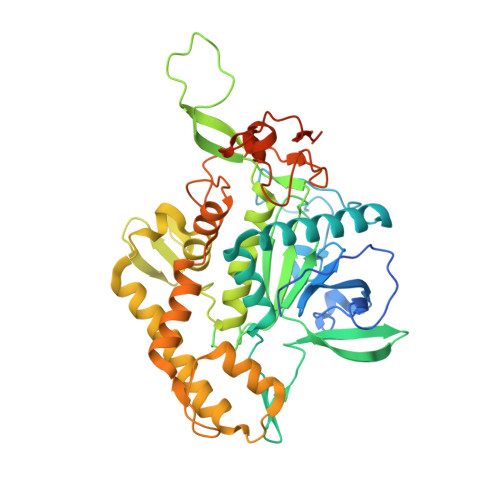Structural characterisation of the catalytic domain of botulinum neurotoxin X - high activity and unique substrate specificity.
Masuyer, G., Zhang, S., Barkho, S., Shen, Y., Henriksson, L., Kosenina, S., Dong, M., Stenmark, P.(2018) Sci Rep 8: 4518-4518
- PubMed: 29540745
- DOI: https://doi.org/10.1038/s41598-018-22842-4
- Primary Citation of Related Structures:
6F47, 6F4E - PubMed Abstract:
Botulinum neurotoxins (BoNTs) are among the most potent toxins known and are also used to treat an increasing number of medical disorders. There are seven well-established serotypes (BoNT/A-G), which all act as zinc-dependent endopeptidases targeting specific members of the SNARE proteins required for synaptic vesicle exocytosis in neurons. A new toxin serotype, BoNT/X, was recently identified. It cleaves not only the canonical targets, vesicle associated membrane proteins (VAMP) 1/2/3 at a unique site, but also has the unique ability to cleave VAMP4/5 and Ykt6. Here we report the 1.35 Å X-ray crystal structure of the light chain of BoNT/X (LC/X). LC/X shares the core fold common to all other BoNTs, demonstrating that LC/X is a bona fide member of BoNT-LCs. We found that access to the catalytic pocket of LC/X is more restricted, and the regions lining the catalytic pocket are not conserved compared to other BoNTs. Kinetic studies revealed that LC/X cleaves VAMP1 with a ten times higher efficiency than BoNT/B and the tetanus neurotoxin. The structural information provides a molecular basis to understand the convergence/divergence between BoNT/X and other BoNTs, to develop effective LC inhibitors, and to engineer new scientific tools and therapeutic toxins targeting distinct SNARE proteins in cells.
- Department of Biochemistry and Biophysics, Stockholm University, SE-106 91, Stockholm, Sweden.
Organizational Affiliation:

















